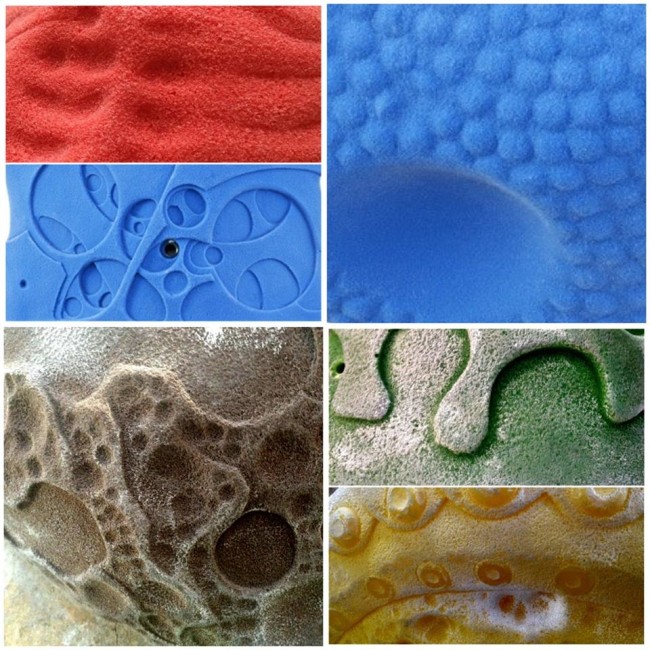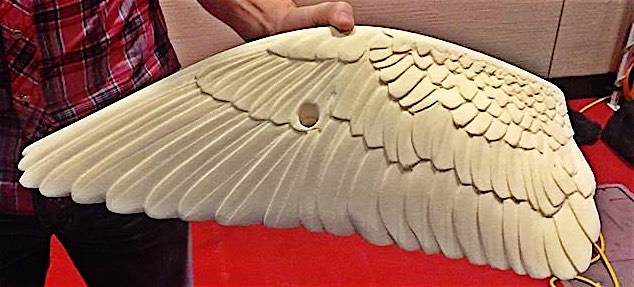
By Jack Simonson
Indoor climbing has come a long way since the first commercial climbing gym opened in 1987. The earliest gyms featured handmade walls and climbing holds made from brittle, heavy resin. Setters used L-wrenches, taped routes, and had limited resources at their disposal. Now, color-matched routes, lightweight and durable plastic shapes, and innovative volumes are the norm.
Climbers, routesetters, and artists have been pushing the limits of climbing hold technology for the last three decades, and a few brand names have been at the forefront of this movement, helping to shape the future of a new industry.
One of the companies is Boulder-based, eGrips, which is celebrating twenty years in business this year.
A Tumultuous Beginning
In 1996, climbers Ian Powell and Ty Foose combined their artistic talents and routesetting experience to form eGrips, a hold company devoted to giving routesetters the tools they needed to push the creative boundaries of indoor rock climbing.
Foose, one of the founders and long-time eGrips shaper, told CBJ that the goal of eGrips was to provide “original and unique designs that were artistically beautiful, exceptionally well crafted, and perfectly shaped with climbing movement and tendon comfort in mind.”
For two years, Powell and Foose shaped holds, poured molds, sanded the edges, and shipped their product to gyms around the country. Their shapes were innovative, durable, and designed with creative routesetting in mind. Gyms and routesetters snapped them up.
In 1998, the duo sold eGrips to legendary grip maker, Pusher. Unfortunately, Pusher decided to produce their holds using a weaker, more brittle mixture, leading to a drop in product demand. “It pretty much tanked the brand,” said Foose. “Less than a year later, [Pusher] didn’t want the company anymore, so they loaded all the molds onto pallets and mailed them back to us.”
By that time, however, Powell and Foose had both moved on to other things. The molds that had defined eGrips were stuffed under a trampoline at CATS gym in Boulder, Colorado and would have been forgotten had it not been for demand from nostalgic routesetters.
Two years later, around 2000, Jessica Franco revived the eGrips name by founding Choke Holds in order to manufacture and distribute eGrips products around the country. “eGrips would not exist today if it were not for Jessica. She provided the vision, effort, and stability the brand needed to continue after it was abandoned by Pusher,” said Foose. For the next few years, Franco and Foose worked to find a manufacturer who would pour eGrips holds according to the company’s standards.
This search led eGrips team to Chuck Demarest, one of the principle scientists and driving forces behind Aragon Elastomers, who worked with them to formulate a new polyurethane mix for pouring climbing holds, which is the industry standard today. “For those few years, my primary task was developing an efficient process for making molds, hollow backs, and castings and training the staff at Aragon how to consistently replicate the quality we demanded,” said Foose. By 2004, Franco and Foose were pushing eGrips in the direction that would influence the industry over the next 12 years.

Innovation
Continuous innovation and creativity have been key factors in the success of eGrips. According to Foose, “Many things that we take for granted as ‘standard’ are originally eGrips innovations. Casting holds in urethane, using hardened washers, employing professional mass manufacturing techniques … bolt on volumes with integrated t-nuts, geometric patterns as texture on holds – these were all first introduced by eGrips.”
Among these considerable advancements in climbing hold design, the most influential may be their role in the development of modern polyurethane hold production. In the early years of routesetting, heavy holds, brittle mixtures, varying textures and wildly different shades of the same colors were standard. The modern convention of light-weight and durable plastic holds, standard hold colors and uniform textures are all a result of the collaboration between eGrips and Chuck Demarest at Aragon Elastomers.
The development of a polyurethane tailored specifically for the needs of hold design has allowed eGrips to produce new, large shapes and features that would be almost unimaginable 15 years ago. The Main Dish, the Bubble Wrap Big Wave, the Myorcan Double Tufa Pinch, and the Foose Weave Beach Ball, are all staples of modern climbing gyms and competition routesetting that would not be possible without the advent of the modern polyurethane mixture. Creative, dynamic features have been made possible through this process, and it has come to define the direction of American routesetting.
Along with their polyurethane mixture, eGrips is known for being one of the earliest producers of dual-texture holds. Dual-texture allow routesetters to be more precise with the movement they force because they feature only one true surface with usable friction. (Voodoo Holds is regarded as the first to market dual-tex holds with the launch of their Tallus line in 1993 and the brand has been influential in pushing texture innovation. They also experimented with urethane formulas during the early 1990’s.)

Evolution
Great Trango Holdings Inc., the company that owns climbing and outdoor brands such as Trango, Tenaya, and Stonewear, saw potential in eGrips and acquired Choke Holds in 2004. “eGrips revolutionized the climbing gym world and routesetting by introducing a material that was substantially better than anything else that was on the market,” said Chris Klinke, President of GTHI. He added, “Jessica Franco was the driver behind creating a more robust infrastructure to help fill the growing need for professional shapes for the growing climbing wall market.”
Trango was a company with considerable manufacturing and distribution resources, while eGrips had the innovation and creativity to influence the future of a budding industry. According to Foose, “eGrips was growing on its own, but joining with Trango and taking advantage of their infrastructure and economies of scale was the next logical step for the development of eGrips.” Trango sought to help grow the company while respecting their vision, to be a place “where artistic expression and climbing meet for shapes and routesetting,” said Klinke.
Chris Danielson, Chairperson of USA Climbing’s Routesetting Committee and a renowned international routesetter, was brought on as a sales representative for eGrips in 2005. “I had known and admired eGrips as a brand for many years prior to being hired,” said Danielson. “eGrips shapes were always among my favorites … but I didn’t know too much about the brand other than that it seemed like a really artist-driven company, with uniquely technical and innovative shapes, great for competition … [they made] artistic tools for the craftsmen.”
What’s Next
Since eGrips started making shapes 20 years ago the climbing hold market has become significantly more crowded. Today the brand faces an onslaught of new competition from quality brands that are innovating and finding new ways to market their grips to routesetters. (There are at least three dozen brands in the USA and Canada alone, and more brands from around the globe are finding a foothold in the Americas each year.) Even though eGrips is one of the oldest and most respected climbing hold companies in America they landed in sixth place on CBJ’s Grip List in 2016 and tenth place in 2015.
“Every year there are new climbing hold brands and as someone who has partnerships with other companies and works with shapes constantly as a routesetter and climber, there’s endless motivation out there,” says Danielson.
This continued push for innovation by newcomers will challenge eGrips to continue to grow and develop. “We are always brainstorming about how to build on classic themes, like the Myorcan, Bubble Wrap and Drop Art, and to come up with new idea … The eGrips brand will always work to innovate with unique designs,” says Danielson.
eGrips is a household name for those in the indoor climbing industry, but this almost wasn’t the case. Innovation, passion, and creativity have kept eGrips from falling into obscurity. Currently, eGrips is thriving and still producing shapes with their hallmark passion and devotion to routesetters.

Climbing Business Journal is an independent news outlet dedicated to covering the indoor climbing industry. Here you will find the latest coverage of climbing industry news, gym developments, industry best practices, risk management, climbing competitions, youth coaching and routesetting. Have an article idea? CBJ loves to hear from readers like you!







